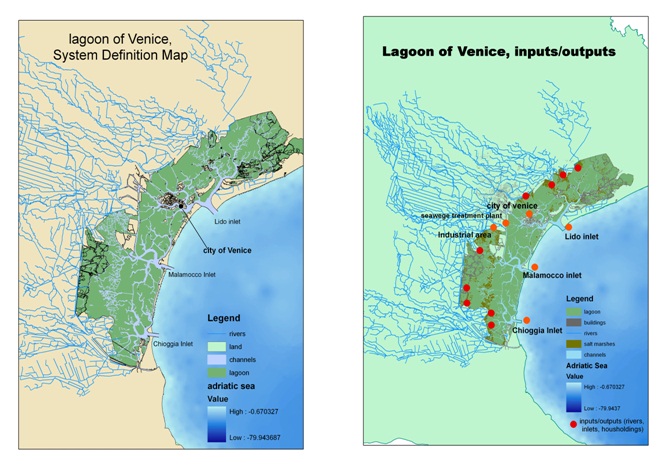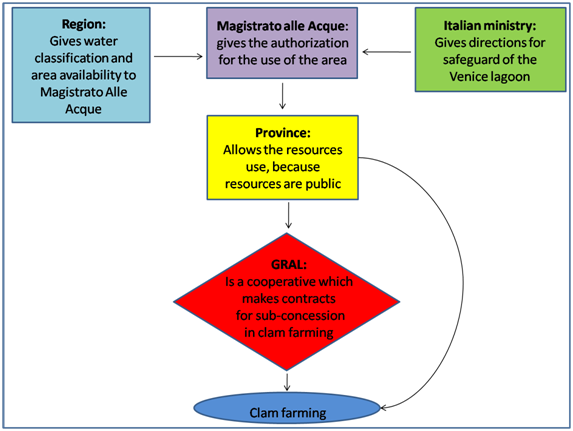Specify boundary conditions [and] relevant internal inputs, controls, constraints, and social and economic demands relative to the Policy Issue(s).
Subtask Description:
Specify boundary conditions [and] relevant internal inputs, controls, constraints, and social and economic demands relative to the Policy Issue(s).
Action points of the implementation:
- List or map the main trans-boundary exchanges that should be included in the ‘virtual’ System.
- List or map the main (natural & anthropogenic) within system inputs or withdrawals of matter & energy to be included in the ‘virtual’ System.
- List the steps from HA to impact relating to the ecosystem dysfunction that provides the ‘problem’.
- Identify the main property rights and Governance structure relating to the Issue, and draw an Institutional Map.
- List the present and potential economic demands likely to be made in the ‘real’ system in relation to the Policy Issue, and which should be included in the ‘virtual’ system.
Area:
Venice Lagoon, Italy.
Policy Issue:
Sustainable management of the clam Tapes philippinarum.
Human Activities:
Industrial and urban activities, maritime transport, tourism, agriculture, clam fishing.
General Information:
One of the most important economic activities in the lagoon is fishing of clams, accounting for 60% of national production. The actual sustainability of the sector is at the moment uncertain: over-fishing, ‘fishing down the food-web’, sediment re-suspension, damage to benthos and habitat destructions are some of the recurrent problems. These days the fishery activity is allowed only within restricted lagoon areas the management of which is given to fishermen cooperatives in order to preserve their productivity by encouraging the fishermen to take care of the water basins assigned to them. Still, there are social problems related to the competition for the seed from natural nurseries, and the competition for the more productive water basins. The main stakeholder concerns are connected to social conflicts, the profitability risks, the quality of the product and the environmental status of the system.
Example of Implementation:

Figure 1: Venice lagoon System definition map and input/output definition map.
Table 1 : Transboundary exchanges of materials and energy.
input |
output |
unit |
Nutrient/organic carbon |
Nutrient/organic carbon |
mg/l, mgC/l |
Pollutants |
|
m g/l |
sediment |
sediment |
m g/g |
|
Other species (seagrass, benthic macrofauna) |
|
Table 2 : Internal inputs or withdrawals of material and energy.
input |
output |
unit |
Nutrient/organic carbon |
Nutrient/organic carbon |
mg/l, mgC/l |
Clam larvae or juveniles |
Harvested clams |
n° ind/l |
Pollutants |
|
m g/l |
sediment |
sediment |
m g/g |
|
Other species (seagrass, benthic macrofauna) |
|
Capital assets, human work, power (oil) |
clams |
|
Table 3 : Governance structure and property rights.
Laws |
|
labelling |
Decreto legislativo 30 dicembre 1992, n. 530, e successive modifiche in attuazione della direttiva 97/61/CE, pubblicato nella Gazzetta Ufficiale - serie generale - n. 296 del 19 dicembre 1998. |
|
Reg. CE 2065/2001 recepito in Italia col Decreto del ministero delle Politiche Agricole e Forestali del 27.03.02 |
|
Decreto Ministeriale 27 marzo 2002. Etichettatura dei prodotti ittici e sistema di controllo. Pubblicato nella Gazzetta Ufficiale n. 84 del 10 aprile 2002 |
Water and product quality |
D. Lgs. 27 gennaio 1992, n. 131 (1). Attuazione della direttiva 79/923/CEE relativa ai requisiti di qualità delle acque destinate alla molluschicoltura. |
|
Decreto Dirigente Regionale n. 234/00 riguardante il riconoscimento di zone di stabulazione del litorale Cavallino-Venezia; |
|
Decreto Dirigente Regionale n. 234/00 riguardante il riconoscimento di zone di stabulazione del litorale Cavallino-Venezia; |
|
Decreto Dirigente Regionale n. 242/00 riguardante il riconoscimento di zone di stabulazione dei litorali Porti brontolo e Caleri-RO |
|
D.G.R.V. 3721/02 e D.G.R.V. 3720/02 riguardanti la classificazione della laguna di Carole |
|
D.G.R.V. 201/01 riguardante il monitoraggio di diossine in laguna centrale, e la sperimentazione sulla detossificazione del prodotto |
|
D.G.R.V. 2201/02 riguardante la ricerca di diossina in ambiti lagunari de Veneto |
|
D.G.R.V. 1828/01 riguardante l’introduzione di documenti di trasporto per la reimmissione |

Figure 2 : Institutional map of clam farming activity in Venice lagoon.
Contact:
Simona Dala Riva, dallariva@corila.it
![[Logo] : Coastal-SAF.eu](/images/logo.png)